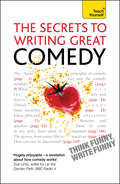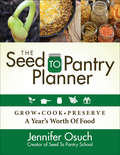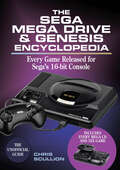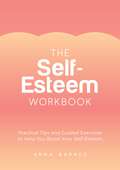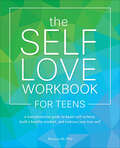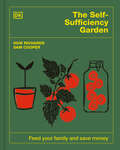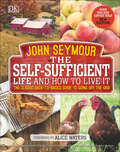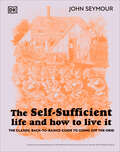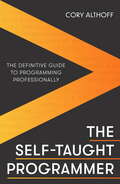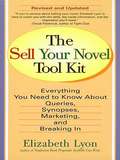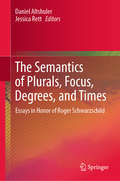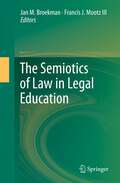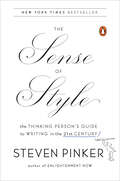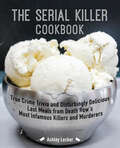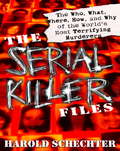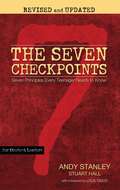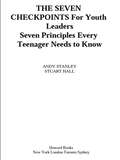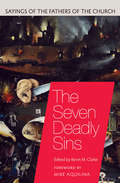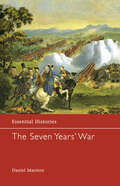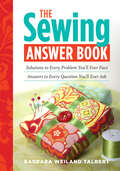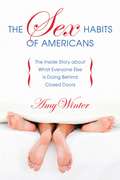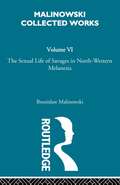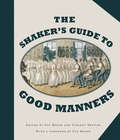- Table View
- List View
The Secrets to Writing Great Comedy
by Lesley BownThe Secrets to Writing Great Comedy will show you how to unlock yourinner anarchist and write fantastic comedy, using a combination ofpractical exercises and creative inspiration. Whatever your preferredgenre, from sitcom to sketch show, you will fi nd guidance on everythingfrom wordplay and visual humour to plots, characters and differentstyles. There is even detailed coverage of how to submit, copyright and,most importantly, get your work noticed.
The Seed to Pantry Planner: Grow, Cook, & Preserve A Year's Worth of Food
by Jennifer OsuchThe first ever guide that helps homesteaders and urban farmers alike feed their families for an entire year from a nutrient dense, fully stocked pantry.The Seed to Pantry Planner is a game changer. No more guessing how many tomato plants are needed to grow to feed a family. DIY farmers simply insert the number of people in their family and get the number of plants that they need to plant. The Seed to Pantry Planner is an actual yearly planner which helps to keep everything in one place, including month-at-a-glance pages for readers to record appointments along with birthdays and week-at-a-glance pages to record daily to-do lists. Within The Seed to Pantry Planner, there are: Charts for food preservation through home canningCharts for food preservation through home dehydratingGenerous worksheet spaceRecipe multiplier worksheetsWorksheets for prioritizing goalsGraphs for planning a gardenSeed starting calendarsWorksheets to keep track of herbs and roots used medicinallyMonthly budget planner worksheetsWeekly menu planning sheets that include planning for preserving
The Sega Mega Drive & Genesis Encyclopedia: Every Game Released for Sega's 16-bit Console
by Chris Scullion“An exhaustive, tremendous look back at one of the most beloved consoles of all time . . . an absolutely barnstorming recollection of a wonderful era.” —Finger GunsThe third book in Chris Scullion’s series of video game encyclopedias, The Sega Mega Drive and Genesis Encyclopedia is dedicated to Sega’s legendary 16-bit video game console. The book contains detailed information on every single game released for the Sega Mega Drive and Genesis in the west, as well as similarly thorough bonus sections covering every game released for its add-ons, the Mega CD and 32X. With nearly a thousand screenshots, generous helpings of bonus trivia and charmingly bad jokes, The Sega Mega Drive and Genesis Encyclopedia is the definitive guide to a legendary gaming system.“The Sega Mega Drive and Genesis Encyclopedia is a must-buy for fans of the console and a perfect addition to any retro game fan’s library.” —Goomba Stomp Magazine
The Self-Esteem Workbook: Practical Tips and Guided Exercises to Help You Boost Your Self-Esteem
by Anna BarnesA healthy self-esteem is key to having a good sense of well-being, but it can often be challenging to feel good about who we are. This workbook contains practical advice, effective tips and guided exercises to help you build your self-esteem. Based on trusted CBT techniques, it will help you to grow your confidence achieve long-term self-belief.
The Self-Love Workbook for Teens: A Transformative Guide to Boost Self-Esteem, Build Healthy Mindsets, and Embrace Your True Self
by Shainna AliDiscover how to change your attitude, build confidence in who you are, and genuinely love yourself through the guided activities and real-world advice in this easy-to-use, friendly workbook for teens and young adults. As a teen, life can be stressful, whether from worrying about looks, performance in school, relationships with friends and family, or societal pressures. It is easy for you to lose focus and feel like you&’re not good enough. The Self-Love Workbook for Teens gives you the tools to conquer self-doubt and develop a healthy mindset. It includes fun, creative, and research-backed exercises, lessons, and tips, including: Interactive activities Reflective exercises Journaling prompts Actionable advice Self-love is a journey, but it is the first step on the path to a happier, more fulfilling life.
The Self-Sufficiency Garden: Feed Your Family and Save Money: THE #1 SUNDAY TIMES BESTSELLER
by Huw Richards Sam CooperEat homegrown food all year round and save money on your weekly shop by following a simple plan for self-sufficiency.Huw Richards and Sam Cooper have spent the past two years planning and trialing their self-sufficiency garden in a 10x13m plot, and now they've worked out the perfect formula. Grow six portions of nutritious veg a day per person following their month-by-month growing plan, which is realistic and flexible with cost, space, and time in mind. Follow this carefully curated year-round growing plan to yield six portions of veg per person per day, plus batching and preserving recipes! Whether you are looking for cost-effective ways to put food on the table and feed your family, a fan of Huw’s YouTube videos and would like to try out the recipes for yourself or a gardener who would like some guidance on how to grow your own food, this book will be great for you.With this gardening book, you will be able to:-Learn about Huw's self-sufficiency ethos, goals, and approaches to growing food-Create your garden and learn how to build all the growing spaces you will need, such as hotbeds and polytunnels-Follow month-by-month planting plans with guidance on key tasks throughout the year and different seasons-Perfect your growing skills with sowing, weeding, watering, and composting.-Discover useful kitchen tips for meal prep, storage, and preserving ideas along with base recipes so you can make the most of your crops. -Find recipes for delicious dishes including soup, curry, tray bakes and salads + dressingsFollow Huw Richards and SamCooper’s tried-and-tested methods and save money while enjoying homegrown food all year. If you are interested in learning more or want more books by Huw Richards, check out these titles: Veg in One Bed, Grow Food For Free, and The Vegetable Grower's Handbook.
The Self-Sufficient Life and How to Live It: Comp Back-to-Basics Guide US AKG 20
by John SeymourEmbrace off-grid green living with the bestselling classic guide to a more sustainable way of life from the father of self-sufficiency. For over 40 years, John Seymour has inspired thousands to make more responsible, enriching, and eco-friendly choices with his advice on living sustainably. The Self-Sufficient Life & How To Live It offers step-by-step instructions on everything from chopping trees to harnessing solar power; from growing fruit and vegetables, and preserving and pickling your harvest, to baking bread, brewing beer, and making cheese. Seymour shows you how to live off the land, running your own smallholding or homestead, keeping chickens, and raising livestock. Featured in pages of this off-grid guide, you will find: - Detailed advice for achieving a self-sufficient lifestyle no matter your outdoor space, including guides for getting the most from urban gardens, allotments, and larger holdings.- Encyclopaedic knowledge on cultivating fruits and vegetables, rearing and preparing livestock, foraging, brewing, and home crafts like woodwork and pottery. - Beautiful illustrated galleries of fruit and vegetables to inspire growers. - Charming original hand-drawn illustrations accompany step-by-step guides to dozens of home crafts and self-sufficiency skills, including storing crops, saddling horses, butchering a pig, making wine, and making a footstool. - A new foreword from a high-profile current follower and advocate of his message.In a world of mass production, intensive farming, and food miles, Seymour&’s words offer an alternative: a celebration of the joy of investing time, labor, and love into the things we need. While we can&’t all be able to move to the countryside, we can appreciate the need to eat food that has been grown ethically or create things we can cherish, using skills that have been handed down through generations. With refreshed, retro-style illustrations and timeless advice reviewed to reflect the latest organic gardening guidelines, this new edition of Seymour&’s classic title is a balm for anyone who has ever sought solace away from the madness of modern life.
The Self-Sufficient Life and How to Live It: The Complete Back-to-Basics Guide
by John SeymourThe Self Sufficient Life and How to Live It is the only book that teaches all the skills needed to live independently in harmony with the land harnessing natural forms of energy, raising crops and keeping livestock, preserving foodstuffs, making beer and wine, basketry, carpentry, weaving, and much more. Our 2003 edition included 150 new full-color illustrations and a special section in which John Seymour, the father of the back to basics movement, explains the philosophy of self-sufficiency and its power to transform lives and create communities. More relevant than ever in our high-tech world, The Self Sufficient Life and How to Live It is the ultimate practical guide for realists and dreamers alike.
The Self-taught Programmer: The Definitive Guide to Programming Professionally
by Cory Althoff'One of the best software design books of all time' - BookAuthorityCory Althoff is a self-taught programmer. After a year of self-study, he learned to program well enough to land a job as a software engineer II at eBay. But once he got there, he realised he was severely under-prepared. He was overwhelmed by the amount of things he needed to know but hadn't learned. His journey learning to program, and his experience in first software engineering job were the inspiration for this book. This book is not just about learning to program, although you will learn to code. If you want to program professionally, it is not enough to learn to code; that is why, in addition to helping you learn to program, Althoff also cover the rest of the things you need to know to program professionally that classes and books don't teach you. The Self-taught Programmer is a roadmap, a guide to take you from writing your first Python program to passing your first technical interview. The book is divided into five sections: 1. Learn to program in Python 3 and build your first program. 2. Learn object-oriented programming and create a powerful Python program to get you hooked. 3. Learn to use tools like Git, Bash and regular expressions. Then use your new coding skills to build a web scraper. 4. Study computer science fundamentals like data structures and algorithms. 5. Finish with best coding practices, tips for working with a team and advice on landing a programming job.You can learn to program professionally. The path is there. Will you take it?From the authorI spent one year writing The Self-Taught Programmer. It was an exciting and rewarding experience. I treated my book like a software project. After I finished writing it, I created a program to pick out all of the code examples from the book and execute them in Python to make sure all 300+ examples worked properly. Then I wrote software to add line numbers and color to every code example. Finally, I had a group of 200 new programmers 'beta read' the book to identify poorly explained concepts and look for any errors my program missed. I hope you learn as much reading my book as I did writing it. Best of luck with your programming!
The Sell Your Novel Tool kit
by Elizabeth LyonIn this book, Elizabeth Lyon offers novelists the wisdom of her experience as an author, book editor, writing instructor, and marketing consultant. Step-by-step, she details what editors want, what questions to ask them, and how to develop a marketing strategy.
The Semantics of Plurals, Focus, Degrees, and Times: Essays in Honor of Roger Schwarzschild
by Daniel Altshuler Jessica RettThis volume is a tribute to Roger Schwarzschild's immense contributions in the formal semantics of nouns, focus, degrees and space, and tense and aspect. Collectively, the papers in the volume reveal parallels across ontological domains, in particular in the context of elements with internal structure, like plural sets, alternative sets, degree intervals, temporal intervals, and vectors. This research suggests that the structure of an entity could inform the semantic behavior of that entity just as much (if not more) than its semantic type or lexical category. And because these structures dictate the formation of semantic alternatives, it can help inform focus semantics and scalar implicature as well. Old questions on plurals, focus and degree expressions get new answers in this collection of papers in honor of Roger Schwarzchild. Roger Schwarzschild is one of the leading scholars in semantics, and the editors have been highly successful in requesting contributions by his teachers, peers and former students. Some papers have circulated in draft form for many years, and find their final home in this edited volume, which well reflects the state of the art in the field. Prof. dr. Henriëtte de Swart, Utrecht University, The Netherlands
The Semiotics of Law in Legal Education
by Jan M. Broekman Francis J. Mootz IIIThis book offers educational experiences, including reflections and the resulting essays, from the Roberta Kevelson Seminar on Law and Semiotics held during 2008 - 2011 at Penn State University's Dickinson School of Law. The texts address educational aspects of law that require attention and that also are issues in traditional jurisprudence and legal theory. The book introduces education in legal semiotics as it evolves in a legal curriculum. Specific semiotic concepts, such as "sign", "symbol" or "legal language," demonstrate how a lawyer's professionally important tasks of name-giving and meaning-giving are seldom completely understood by lawyers or laypeople. These concepts require analyses of considerable depth to understand the expressiveness of these legal names and meanings, and to understand how lawyers can "say the law," or urge such a saying correctly and effectively in the context of a natural language that is understandable to all of us. The book brings together the structure of the Seminar, its foundational philosophical problems, the specifics of legal history, and the semiotics of the legal system with specific themes such as gender, family law, and business law.
The Sense of Style: The Thinking Person's Guide To Writing In The 21st Century!
by Steven Pinker"Charming and erudite . . . The wit and insight and clarity he brings . . . is what makes this book such a gem." --Time.com Why is so much writing so bad, and how can we make it better? Is the English language being corrupted by texting and social media? Do the kids today even care about good writing--and why should we care?In this entertaining and eminently practical book, the cognitive scientist, dictionary consultant, and New York Times-bestselling author Steven Pinker rethinks the usage guide for the twenty-first century. Using examples of great and gruesome modern prose while avoiding the scolding tone and Spartan tastes of the classic manuals, he shows how the art of writing can be a form of pleasurable mastery and a fascinating intellectual topic in its own right. The Sense of Style is for writers of all kinds, and for readers who are interested in letters and literature and are curious about the ways in which the sciences of mind can illuminate how language works at its best.From the Trade Paperback edition.
The Sensory Processing Disorder Answer Book: Practical Answers to the Top 250 Questions Parents Ask
by Tara DelaneyThe Sensory Processing Disorder Answer Book provides advice and answers to your most pressing questions about SPD. Written in a question and answer format, The Sensory Processing Disorder Answer Book helps you understand SPD, conquer your fears, and seek help for your child when necessary.
The Serial Killer Cookbook: True Crime Trivia and Disturbingly Delicious Last Meals from Death Row's Most Infamous Killers and Murderers
by Ashley LeckerPerfect for true crime lovers, this cookbook features favorite meals and facts about some of America&’s most notorious criminals. Bring your love of true crime into the kitchen with meals ranging from the bizarre (a single unpitted black olive) to the gluttonous (a dozen deep-fried shrimp, a bucket of fried chicken, French fries, and a pound of strawberries), inspired by Ted Bundy, John Wayne Gacy, and other notorious death row inmates. The perfect gift for murderinos and true crime fans, The Serial Killer Cookbook: Last Meals pairs serial killer trivia with the recipes of the meals these killers ate during their final hours. With full-color photos, chilling true crime facts, and easy-to-follow steps, you&’ll be cooking up killer meals in no time. This collection of recipes is both delicious and surprising, and spans breakfast staples to indulgent desserts, including: · Seared Steak, Hash Browns, Toast, and Fried Eggs (given to but not eaten by Ted Bundy, serial killer) · Chicken Parmesan and Alfredo Pasta (eaten by Ruth Snyder, murderer) · Justice, Equality, and World Peace (eaten by Odell Barnes, murderer) · Mac and Cheese (eaten by Gustavo Julian Garcia, murderer) · And much more!
The Serial Killer Files: The Who, What, Where, How, and Why of the World's Most Terrifying Murderers
by Harold SchechterTHE DEFINITIVE DOSSIER ON HISTORY'S MOST HEINOUS! Hollywood's make-believe maniacs like Jason, Freddy, and Hannibal Lecter can't hold a candle to real life monsters like John Wayne Gacy, Ted Bundy, Jeffrey Dahmer, and scores of others who have terrorized, tortured, and terminated their way across civilization throughout the ages. Now, from the much-acclaimed author of Deviant, Deranged, and Depraved, comes the ultimate resource on the serial killer phenomenon. Rigorously researched and packed with the most terrifying, up-to-date information, this innovative and highly compelling compendium covers every aspect of multiple murderers--from psychology to cinema, fetishism to fan clubs, "trophies" to trading cards. Discover: WHO THEY ARE: Those featured include Ed Gein, the homicidal mama's boy who inspired fiction's most famous Psycho, Norman Bates; Angelo Buono and Kenneth Bianchi, sex-crazed killer cousins better known as the Hillside Stranglers; and the Beanes, a fifteenth-century cave-dwelling clan with an insatiable appetite for human flesh. HOW THEY KILL: They shoot, stab, and strangle. Butcher, bludgeon, and burn. Drown, dismember, and devour . . . and other methods of massacre too many and monstrous to mention here. WHY THEY DO IT: For pleasure and for profit. For celebrity and for "companionship." For the devil and for dinner. For the thrill of it, for the hell of it, and because "such men are monsters, who live beyond the frontiers of madness." PLUS: in-depth case studies, classic killers' nicknames, definitions of every kind of deviance and derangement, and much, much more. For more than one hundred profiles of lethal loners and killer couples, Bluebeards and black widows, cannibals and copycats-- this is an indispensable, spine-tingling, eye-popping investigation into the dark hearts and mad minds of that twisted breed of human whose crimes are the most frightening ... and fascinating.
The Seven Checkpoints for Student Leaders
by Stuart Hall Louie Giglio Andy StanleyThe Seven Checkpoints for Student Leaders is more than a book; it is a ministry plan. It goes far beyond the "how to" of youth ministry and provides youth ministers, youth works, and parents with the content that students need to equip them for 'life beyond youth group." The material in this book and the companion book The Seven Checkpoints Student Journal reveals what Stanley calls "the irreducible minimum"--the essential principles upon which an entire youth ministry can be built. Stanley and Hall offer some unorthodox but very sensible approaches to planning and maintaining a youth group over a long period of time with a specific goal in mind. The book outlines a strategy for effectively teaching students over the course of their time in school, and this new updated edition is what every leader needs to keep up with the ever-changing challenges students face. Stanley and Hall identify seven "checkpoints" that are the most important and critical issues facing teens: 1. Authentic Faith 2. Spiritual Disciplines 3. Moral Boundaries (this section deals primarily with issues of sexual purity and dating) 4. Healthy Friendships 5. Wise Choices 6. Ultimate Authority 7. Others FirstPractical application, biblical principles, and realistic approaches for facing modern challenges facilitate teaching for busy youth leaders that will make an impact for eternity.
The Seven Checkpoints for Student Leaders: Seven Principles Every Teenager Needs to Know
by Stuart Hall Louie Giglio Andy StanleyThe Seven Checkpoints for Student Leaders is more than a book; it is a ministry plan. It goes far beyond the "how to" of youth ministry and provides youth ministers, youth works, and parents with the content that students need to equip them for 'life beyond youth group." The material in this book and the companion book The Seven Checkpoints Student Journal reveals what Stanley calls "the irreducible minimum"--the essential principles upon which an entire youth ministry can be built. Stanley and Hall offer some unorthodox but very sensible approaches to planning and maintaining a youth group over a long period of time with a specific goal in mind. The book outlines a strategy for effectively teaching students over the course of their time in school, and this new updated edition is what every leader needs to keep up with the ever-changing challenges students face. Stanley and Hall identify seven "checkpoints" that are the most important and critical issues facing teens: 1. Authentic Faith 2. Spiritual Disciplines 3. Moral Boundaries (this section deals primarily with issues of sexual purity and dating) 4. Healthy Friendships 5. Wise Choices 6. Ultimate Authority 7. Others FirstPractical application, biblical principles, and realistic approaches for facing modern challenges facilitate teaching for busy youth leaders that will make an impact for eternity.
The Seven Checkpoints for Youth Leaders
by Stuart Hall Andy StanleyImagine meeting with the parents of your students and showing them the seven principles that serve as the foundation for all you will teach your kids. Imagine having a content calendar that can be used to guide the development of your activity calendar throughout the year. Imagine having a handful of carefully crafted principles to choose from in developing the theme of every camp of retreat. These are just a few of the advantages of adopting the seven-checkpoints strategy. But the greatest advantage is this: You will know that you are doing more than providing exciting activities -- you are changing lives for eternity. A New Strategy for Youth Ministry Andy Stanley and Stuart Hall, both respected and effective leaders in the Christian Community, have developed a ground-breaking, dynamic plan for youth ministry of the coming decades. The Seven Checkpoints for Youth Leaders and the companion The Seven Checkpoints Student Journal presents a plan for a student's entire career in a youth group. The challenges facing our youth grow every year. Quick fixes and short-term programs will not provide the life-strengthening results needed for the teens of today. This revolutionary approach promises and delivers what is needed in the world of youth ministries around the country today. So what are you waiting for? You have a life to build. Open up this book and get the seven.
The Seven Deadly Sins: Sayings of the Fathers of the Church (Sayings Of The Fathers Of The Church Ser.)
by Kevin M. Clarke&“Read this not just for intellectual enjoyment but to discover a centuries-old, proven path for conquering your worst sins&” (Brandon Vogt, author of Why I Am Catholic). Gluttony. Lust. Greed. Anger. Sloth. Envy. Pride. The capital vices are the gateway drugs to countless sins. But where did this tradition come from? Unsurprisingly, it can be traced back to the teachings of the Church Fathers, whose words—included in this book—answer such questions as: So how do the capital sins spawn other vices in the soul? How does one cultivate the virtues that heal the soul from those vices? How are gluttony and lust related? What role does almsgiving have in soothing the passion of anger? As the path of the book descends through the vices, the words of the Fathers will assist readers in being more realistic about the attacks upon the soul. Edifying and medicinal, each chapter begins with vice and ends with virtue, so one&’s path through the chapters represents a sort of ascent out of sin and on to the road to righteousness. The text gives special attention to the thoughts of Augustine of Hippo, Evagrius of Pontus, John Cassian, Gregory the Great, and Maximus the Confessor. &“An illuminating survey of the Church Fathers&’ wisdom on the capital vices that have burdened us since time immemorial.&” —Curtis A. Martin, Founder and CEO of FOCUS &“A wonderfully helpful compendium of insights and advice from the Church Fathers . . . You will be astonished at how relevant and applicable is this ancient wisdom to the life of the modern-day Christian. Highly recommended.&” —James Martin, SJ, author of Jesus: A Pilgrimage
The Seven Years' War (Essential Histories #6)
by Daniel MarstonThe closest thing to total war before the First World War, the Seven Years' War was fought in North America, Europe, the Caribbean and India with major consequences for all parties involved. This fascinating book is the first to truly review the grand strategies of the combatants and examine the differing styles of warfare used in the many campaigns. These methods ranged from the large-scale battles and sieges of the European front to the ambush and skirmish tactics used in the forests of North America. Daniel Marston's engaging narrative is supported by personal diaries, memoirs, and official reports.
The Sewing Answer Book: Solutions to Every Problem You’ll Ever Face; Answers to Every Question You’ll Ever Ask
by Barbara Weiland TalbertThis informative and encouraging guide offers proven solutions to all of your most stubborn sewing problems. With a question-and-answer format that makes it easy to find what you need, Barbara Weiland Talbert includes tips on selecting the perfect patterns, choosing the right size needles, comparing seam types, and much more. No matter your sewing experience or whether you prefer to use a machine or sew by hand, The Sewing Answer Book will help you hone your skills while inspiring you to try new and exciting techniques.
The Sex Habits of Americans: The Inside Story about What Everyone Else Is Doing Behind Closed Doors
by Amy WinterWe all know what we're doing with our significant others, booty calls, and one-night stands when the lights go out, but what about other Americans? Indulge your voyeuristic curiosity with The Sex Habits of Americans, a sizzling collection of surveys from Playboy, Trojan, and Men's Health that lets you in on the truths, myths, and raunchy details of the sex lives of Americans, including: - More men than women turn down sex because of stress- Men are more willing to wait until marriage before hopping in the sack than women are- 64% of Americans have sex at least once a week- Missionary is the most preferred position- 82% of women have had at least one casual sexual encounter- 56% of women have "faked it" - Matthew McConaughey is the number one celeb turn-on- And much, much moreAmy Winter's extensive research offers you a one-stop volume of shocking and hilarious facts about our most commonly shared pastime. You'll giggle and gasp as you delve into the way Americans think and feel about sex and how they get it on.
The Sexual Lives of Savages: [1932/1952] (Bronislaw Malinowski Ser.)
by MalinowskiThis volume provides an ethnographic account of courtship, marriage and family life among the people of the Trobriand Islands.
The Shaker's Guide to Good Manners
by Flo Morse Vincent NewtonThe intimate guide to life as a Shaker in 19th century America "Never make more free with your inferiors than you are willing they should make with you; it learns them to be saucy." Such sage words of advice come from Mother Ann Lee's Society of the Shakers, who in 1844 published A Juvenile Guide, or Manual of Good Manners, Consisting of Counsels, Instructions, & Rules of Deportment for the Young. Known for their piety, their economy, and (perhaps most famously) their celibacy, the Shakers knew a thing or two about etiquette and proper decorum. With this incredible artifact of a bygone era, you can experience what it was like to live in a rural 19th century religious community, where children were taught to "be careful not to talk too loud, nor too much" and to "always have a place for every thing, and keep every thing in its place."
